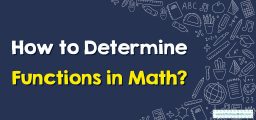How to Understand Functions
In mathematics, a function is a relation between a set of inputs (often referred to as the domain) and a set of possible outputs (often called the range). Each input is related to exactly one output. This means that for every element in the domain, there is a unique element in the range that the function maps to.

Step-by-step Guide to Understand Functions
Here is a step-by-step guide to understand functions:
Step 1: Grasp the Fundamental Definition
- A function is a special type of relation where each input (from the domain) corresponds to exactly one output (in the range).
Step 2: Differentiate Between Relations and Functions
- Not all relations are functions. A vertical line test can determine this visually: if a vertical line intersects a graph at more than one point, it’s not a function.
Step 3: Explore Various Representations
- Functions can be presented in multiple formats: algebraic equations, graphs, tables, or even verbal descriptions. Familiarize yourself with these variations.
Step 4: Delve into Function Notation
- Understand the notation \(f(x)\) where \(f\) denotes the function, and \(x\) is the input. The entire expression represents the output for the given \(x\).
Step 5: Understand the Domain and Range in-depth
- As discussed previously, the domain comprises possible input values, while the range consists of resultant output values. For complex functions, determining these might involve solving inequalities or analyzing asymptotic behavior.
Step 6: Explore Different Types of Functions
- Linear Functions: Represented by straight lines.
- Quadratic Functions: Parabolic in nature.
- Exponential and Logarithmic Functions: Deal with growth and decay.
- Trigonometric Functions: Originating from circle geometry.
- Rational, Radical, and Polynomial Functions: Various algebraic forms with their peculiarities.
- Piecewise Functions: Defined in pieces, each valid in a specific interval.
- Implicit Functions: Not explicitly solved for one variable.
Step 7: Dive into Composite and Inverse Functions
- Composite Functions: Formed by applying one function after another \((f(g(x)))\).
- Inverse Functions: Switch the roles of input and output. If \(y=f(x)\), then the inverse is denoted as \(f\)−1\((y)\).
Step 8: Examine Function Transformations
- Familiarize yourself with how functions change with transformations: translations (shifts), dilations (stretches/shrinks), and reflections.
Step 9: Study Limit Behavior and Continuity
- Understand the concept of limits, and how functions behave as they approach certain values.
- Explore what it means for a function to be continuous or discontinuous at a point.
Step 10: Operate with Functions
- Learn to add, subtract, multiply, and divide functions.
- Understand the resultant domain restrictions.
Step 11: Experiment with Real-world Applications
- Recognize how functions model various real-world phenomena, from population growth to sound waves.
Step 12: Engage in Advanced Topics (for the avid learner)
- Taylor and Maclaurin Series: Approximating functions with polynomials.
- Fourier Series: Decomposing functions into sinusoidal components.
- Laplace and Z-transforms: Used in engineering and control systems.
Step 13: Continual Reflection and Exploration
- Revisit concepts, practice with various problems, and seek deeper understanding.
- Use tools like graphing calculators or software (e.g., Desmos, MATLAB) to visualize and experiment.
Understanding functions, especially amidst high variation and complexity, is a journey. It’s an interplay between theory, application, and intuition. Embrace the intricacies, and remember that mastery comes with patience and practice.
Examples:
Example 1:
Given the set of ordered pairs \(S=\){\((4,6),(5,7),(6,8),(4,9)\)}, does \(S\) represent a function?
Solution:
Notice that the input value \(4\) corresponds to both \(6\) and \(9\). Since the same input has two different outputs, \(S\) does not represent a function.
Example 2:
Given the set of ordered pairs \(T=\){\((−2,0),(0,−1),(2,1),(3,2)\)}, does \(T\) represent a function?
Solution:
Every input value in \(T\) corresponds to exactly one output. Therefore, \(T\) does represent a function.
Related to This Article
More math articles
- FREE Praxis Core Math Practice Test
- FREE 4th Grade SBAC Math Practice Test
- The Ultimate College Mathematics Course (+FREE Worksheets & Tests)
- Integrals: Complete Explanation of the Applications and Use
- How to Use Exponents to Write Powers of Ten?
- How to Motivate your Child to Learn Math?
- FREE SSAT Lower Level Math Practice Test
- How to Divide Rational Expressions? (+FREE Worksheet!)
- 5th Grade KAP Math Worksheets: FREE & Printable
- The Ultimate AP Calculus AB Course


























What people say about "How to Understand Functions - Effortless Math: We Help Students Learn to LOVE Mathematics"?
No one replied yet.